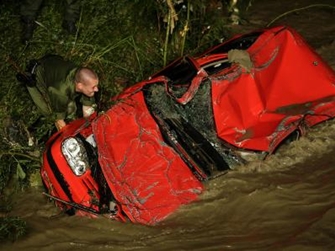CEDIM - Flood risk in a changing climate
- Contact:
Dr. G. Schädler
- Project Group:
IMK-TRO
- Funding:
CEDIM
Short description
The CEDIM-project “Flood hazard in a changing climate” (Hochwassergefahr durch Klimawandel) was a cooperation between IMK-TRO, IMK-IFU, IWG (all KIT) and the Hydrology Section of GFZ. It investigated whether there is an increased probability for flood events in medium and small sized river catchments in Germany for the next few decades
Aims
 Floods in small and medium-sized river catchments have often been a focus of attention in the past. In contrast to large rivers like the Rhine, the Elbe or the Danube, discharge can increase very rapidly in such catchments; we are thus confronted with a high damage potential combined with almost no time for advance warning. Since the heavy precipitation events causing such floods are often spatially very limited, they are difficult to forecast; long-term provision is therefore an important task, which makes it necessary to identify vulnerable regions and to develop prevention measures. For that purpose, one needs to know how the frequency and the intensity of floods will develop in the future, especially in the near future, i.e. the next few decades. Besides providing such prognoses, an important goal of this project was also to quantify their uncertainty.
Floods in small and medium-sized river catchments have often been a focus of attention in the past. In contrast to large rivers like the Rhine, the Elbe or the Danube, discharge can increase very rapidly in such catchments; we are thus confronted with a high damage potential combined with almost no time for advance warning. Since the heavy precipitation events causing such floods are often spatially very limited, they are difficult to forecast; long-term provision is therefore an important task, which makes it necessary to identify vulnerable regions and to develop prevention measures. For that purpose, one needs to know how the frequency and the intensity of floods will develop in the future, especially in the near future, i.e. the next few decades. Besides providing such prognoses, an important goal of this project was also to quantify their uncertainty.
Method
These questions were studied by a team of meteorologists and hydrologists from KIT and GFZ. They simulated the natural chain “large-scale weather – regional precipitation – catchment discharge” by a model chain “global climate model (GCM) – regional climate model (RCM) – hydrological model (HM)”. As a novel feature, we performed so-called ensemble simulations in order to estimate the range of possible results, i.e. the uncertainty: we used two GCMs with different realizations, two RCMs and three HMs. The ensemble method, which is quite standard in physics, engineering and recently also in weather forecasting has hitherto rarely been used in regional climate modeling due to the very high computational demands. In our study, the demand was even higher due to the high spatial resolution (7 km by 7 km) we used; presently, regional studies use considerably larger grid boxes of about 100 km². However, our study shows that a high resolution is necessary for a realistic simulation of the small-scale rainfall patterns and intensities. This combination of high resolution and an ensemble using results from global, regional and hydrological models is unique.
Results
By way of example, we considered the low-mountain range rivers Mulde and Ruhr and the more alpine Ammer river in this study (Fig. 1), all of which had severe flood events in the past. Our study confirms that heavy precipitation events will occur more frequently in the future. Does this also entail an increased flood risk? Our results indicate that in any case, the risk will not decrease. However, each catchment reacts differently, and different models may produce different precipitation and runoff regimes, emphasizing the need of ensemble studies. A statistically significant increase of floods is expected for the river Ruhr in winter and in summer. For the river Mulde, we observe a slight increase of floods during summer and autumn, and for the river Ammer a slight decrease in summer and a slight increase in winter (Fig. 2).
 Fig. 1: The catchments considered in this study: Ammer (green), Ruhr (red) and Mulde (blue). |
 Fig. 2: Changes in the discharge return periods for winter (left) and summer (right) half years for Ammer (Weilheim), Mulde (Bad Düben) and Ruhr (Wetter). Shaded areas indicate one standard deviation of the ensemble. |
Publications
Berg, P., Wagner, S., Kunstmann, H., Schädler, G., 2012: High resolution regional climate model simulations for Germany: Part I – validation. Clim. Dyn., accepted
Wagner, S., Berg, P., Schädler, G., Kunstmann, H., 2012: High resolution regional climate model simulations for Germany: Part II – projected climate changes. Clim. Dyn., accepted
